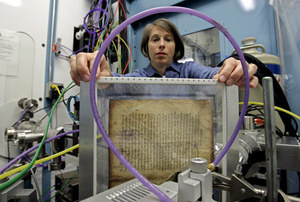At first glance, the manuscript appears to be a medieval Christian prayer book.
But on the same pages as the prayers, experts using a high-tech imaging system have discovered commentary likely written in the third century A.D. on a work written around 350 B.C. by the Greek philosopher Aristotle.
The discovery is the third ancient text to emerge from the layers of writing on the much reused pages. In 2002 researchers had uncovered writings by the mathematician Archimedes and the fourth-century B.C. politician Hyperides.
Last year one of the pages was found to contain a famous work by Archimedes about buoyancy that had previously been known only from an incomplete Latin translation.
Project director William Noel, curator of manuscripts at the Walters Art Museum in Baltimore, Maryland, called the latest discovery a "sensational find."
The findings were presented today at a general meeting of the American Philosophical Society in Philadelphia, Pennsylvania.
Reuse, RecycleThe book, known as the Archimedes Palimpsest, was first analyzed in 1906, when a Danish researcher recognized that it contained works by the ancient mathematician.
In the 10th century a scribe had copied the ancient Greek manuscripts from papyrus scrolls onto parchment - thin leaves of treated animal skin.
Later the writing was washed out using a solvent such as orange juice and overwritten with new text - a process known as palimpsesting.

|
| ©Paul Sakuma/AP
|
Abigail Quandt of the Walters Art Museum in Baltimore, Maryland, places a page of the Archimedes Palimpsest into an x-ray scanner at Stanford University's Linear Accelerator Center on August 4, 2006.
Since 2002 researchers have been using a scanning technique called multispectral imaging to reveal older texts hidden under the words of a medieval Christian prayer book.
The latest scans show commentary likely written in the third century A.D. on a work by the ancient Greek philosopher Aristotle.
|
"In those days, parchment writing materials were so valuable that they were commonly reused when the book was considered out of date or if the subject was judged inappropriate or less valuable," Roger L. Easton, of the Rochester Institute of Technology, wrote in an email.
By the 12th century, pages from five different earlier works had been erased, overwritten, and compiled into a Christian prayer book, the Euchologion - what is now called the Archimedes Palimpsest.
Since 2002 scientists have been using a technique known as multispectral imaging to take digital photographs of the book's pages at different wavelengths.
The images enable the researchers to pull hidden words out from behind the religious writings.
"There are seven quite large double-sided leaves of new text. We have deciphered around half of this so far," said Robert Sharples, project team member and a classicist at University College London.
After the Archimedes and Hyperides works were found, the team fine-tuned their multispectral imaging technique.
Revisiting some of the more difficult pages in the book revealed the writings on Aristotle.
"Even though I couldn't read ancient Greek, just the fact that I could see the words gave me shivers," Easton told BBC News.
Experts on ancient Greek texts are currently scouring the newfound work.
Clues, such as a name in the margin, indicate that the writings are an early commentary on Aristotle's Categories, one of the foundations of Western studies of logic.
"If this is the case, then it is an immensely significant find and very exciting," said David Evans, professor of logic and metaphysics at Queens University Belfast in Ireland.
The most likely author of the new find is thought to be Alexander of Aphrodisias.
"He was a philiosopher in his own right and a very important and insightful commentator," Evans said.
Translation of the text so far suggests that it may provide further insight into a debate on Aristotle's theory of classification.
"We have one book that contains three texts from the ancient world that are absolutely central to our understanding of mathematics, politics, and now philosophy," Noel, of the Walters Art Museum, told BBC News.
"I am at a loss for words at what this book has turned out to be. To make these discoveries in the 21st century is frankly nutty - it is just so exciting."
How appropriate that the medieval church would "recycle" important scientific and philosophical works. No doubt the church leaders got quite a chuckle out of that one.